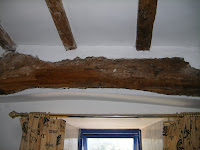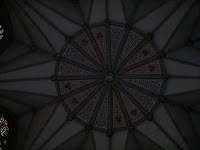Here's our nearest local castle, Dryslwyn. If you've seen any of these photos before, tough! Most annoyingly, I can't find the best pics, which are the views of the Towy Valley from the top, the meanders in the river etc. May try and update later.






A slightly old-fashioned look on life in the wet Welsh countryside.

Hope, expectation, Bright promises.
The Star is one of the great cards of faith, dreams realised
The Star is a card that looks to the future. It does not predict any immediate or powerful change, but it does predict hope and healing. This card suggests clarity of vision, spiritual insight. And, most importantly, that unexpected help will be coming, with water to quench your thirst, with a guiding light to the future. They might say you're a dreamer, but you're not the only one.










 These wedges will be hammered home to widen the pegs and hold them firmly in place.
These wedges will be hammered home to widen the pegs and hold them firmly in place.

 I am very fortunate to live in an very old house, on the site of a very much older one. I have found out some of its history, but much is still hidden. When I was tidying up this week, I found some of the research I had done on the house - at one time it was going to be the topic of my Dissertation for my archaeology degree, but then I decided I would write about the equine iconography of Pictish sculptures instead. Now it will be an illustrated booklet - a copy for us and a copy for the next custodians of this house when we finally move and downsize.
I am very fortunate to live in an very old house, on the site of a very much older one. I have found out some of its history, but much is still hidden. When I was tidying up this week, I found some of the research I had done on the house - at one time it was going to be the topic of my Dissertation for my archaeology degree, but then I decided I would write about the equine iconography of Pictish sculptures instead. Now it will be an illustrated booklet - a copy for us and a copy for the next custodians of this house when we finally move and downsize.


 Part of the mill machinery went through here. There is a corresponding wear-mark in the oak flooring 1 1/2 floors lower.
Part of the mill machinery went through here. There is a corresponding wear-mark in the oak flooring 1 1/2 floors lower. A putlog from 18thC? or earlier building scaffolds.
A putlog from 18thC? or earlier building scaffolds.



 This was the most amazing piece of stained glass, but I have yet to check my bestiary and work out exactly WHAT beastie is being ridden - has a face like a lion, but hooves and not paws and he has a fierce face on the end of his tail!
This was the most amazing piece of stained glass, but I have yet to check my bestiary and work out exactly WHAT beastie is being ridden - has a face like a lion, but hooves and not paws and he has a fierce face on the end of his tail! Two of the windows in the Chapter House which had the most amazing atmosphere and energies.
Two of the windows in the Chapter House which had the most amazing atmosphere and energies. Can you imagine working upside down making this?
Can you imagine working upside down making this? More stained glass.
More stained glass. One of the beautiful little streets in the Shambles area of York.
One of the beautiful little streets in the Shambles area of York. A lovely cottage garden near the University.
A lovely cottage garden near the University. Also near the University - pretty cottage and garden.
Also near the University - pretty cottage and garden.

 The Elderflower Champagne (18 litres) and Elderflower Syrup are in plastic bottles at the far end. My jams and chutneys and pickles are in the nearer view. The two little tan coloured pots are my Elderflower Handcream, and just beyond them is a mesh cover to keep flies off food such as cakes or pies.
The Elderflower Champagne (18 litres) and Elderflower Syrup are in plastic bottles at the far end. My jams and chutneys and pickles are in the nearer view. The two little tan coloured pots are my Elderflower Handcream, and just beyond them is a mesh cover to keep flies off food such as cakes or pies. On the top shelf I have quite a few tins - beans, potatoes, fruit, sardines, tuna, soup etc. I have several weeks' supply. The white plank in the middle needs painting - it was last used when we had the kitchen floor up (new concrete base being laid) and so it is still splashed with concrete! It was just the right length though . . .
On the top shelf I have quite a few tins - beans, potatoes, fruit, sardines, tuna, soup etc. I have several weeks' supply. The white plank in the middle needs painting - it was last used when we had the kitchen floor up (new concrete base being laid) and so it is still splashed with concrete! It was just the right length though . . . The preserves end. It will be added to this week as I got a box of bananas today (£1) and intend to make Banana Jam, for bartering for eggs!
The preserves end. It will be added to this week as I got a box of bananas today (£1) and intend to make Banana Jam, for bartering for eggs! This was the most amazing piece of stained glass, but I have yet to check my bestiary and work out exactly WHAT beastie is being ridden - has a face like a lion, but hooves and not paws.
This was the most amazing piece of stained glass, but I have yet to check my bestiary and work out exactly WHAT beastie is being ridden - has a face like a lion, but hooves and not paws. Two of the windows in the Chapter House which had the most amazing atmosphere and energies.
Two of the windows in the Chapter House which had the most amazing atmosphere and energies. Can you imagine working upside down making this?
Can you imagine working upside down making this? More stained glass.
More stained glass. One of the beautiful little streets in the Shambles area of York.
One of the beautiful little streets in the Shambles area of York. A lovely cottage garden near the University.
A lovely cottage garden near the University. Also near the University - pretty cottage and garden.
Also near the University - pretty cottage and garden.